Gorilla Habituation Experience in Uganda takes you for an amazing 4 hour encounter with mountain gorillas. Over the years, an encounter with mountain gorillas has become one of the most popular wildlife attractions while on an African safari. Tourists from all corners of the world travel to Africa every year with the sole purpose of seeing mountain gorillas. These giant primates can only be found in East and Central Africa. They feel at home in the dense, humid and mountainous forests of Bwindi, Volcanoes, Mgahinga and the Virunga National Parks.
Mountain Gorillas, like any other wild animal have a natural fear for humans. They will move away or become aggressive if approached by humans. Gorilla charging is rare but can occur if a wild group is 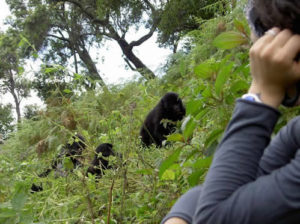 approached without undergoing the process of habituation. Mountain Gorilla habituation is the process of getting these gracious and adorable creatures comfortable with humans in their presence. The gorilla habituation process normally takes two to three years but can go up to five years.
approached without undergoing the process of habituation. Mountain Gorilla habituation is the process of getting these gracious and adorable creatures comfortable with humans in their presence. The gorilla habituation process normally takes two to three years but can go up to five years.
Gorilla habituation usually involves a group of trackers, guides, and researchers who approach a chosen gorilla group in a non-threatening manner. Their objective is to find the best way to communicate with the gorillas. This can be risky in the sense that the dominant silverback loves to exert its dominance. Some form of aggressiveness should be expected. The key to gorilla habituation is to win the favor of the dominant male. Once that is done, he will allow Researchers get close to other members of the group. Once the habituation process is complete, any form of gorilla aggression towards humans is significantly reduced. Tourists can begin to seem them. It is important to note that the naming of gorilla group members is done during the habituation process.
Gorilla Habituation Review
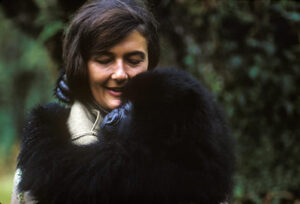 The Gorilla Habituation process started as early as the 1960’s in central Africa led by Dr Dian Fossey. Fossey pioneered the gorilla habituation process. She became an expert in tracking, identification and range mapping among other research methods which are still being used by Gorilla conservation authorities. Gorilla habituation is a useful tool for gorilla conservation programs and research in a sense that it allows for easy monitoring of the security, health, population trends, social behavior and feeding habits of gorilla groups. Through gorilla habituation, it is possible to estimate the revenue generated to local communities, government and businesses – especially tourism related businesses. Gorilla habituation comes with risks and is time consuming. It exposes gorillas to risks including new diseases as a result of constant contact with humans.
The Gorilla Habituation process started as early as the 1960’s in central Africa led by Dr Dian Fossey. Fossey pioneered the gorilla habituation process. She became an expert in tracking, identification and range mapping among other research methods which are still being used by Gorilla conservation authorities. Gorilla habituation is a useful tool for gorilla conservation programs and research in a sense that it allows for easy monitoring of the security, health, population trends, social behavior and feeding habits of gorilla groups. Through gorilla habituation, it is possible to estimate the revenue generated to local communities, government and businesses – especially tourism related businesses. Gorilla habituation comes with risks and is time consuming. It exposes gorillas to risks including new diseases as a result of constant contact with humans.
Gorilla Habituation in Bwindi Impenetrable forest
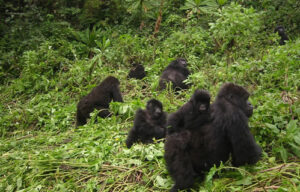 Mountain Gorilla conservation and habituation started in the early 90`s when Bwindi Impenetrable forest was declared a National Park. The habituation process begun with three gorilla groups – the Katendegyere and Mubare groups in the Buhoma sector and the Kyagulilo Group in the Ruhiji sector of Bwindi. The first two groups were open to tourism activities in 1993. However, the Katendegyere group which consisted of 11 individuals (reducing to just 3 in 1998) crossed to the Democratic Republic of Congo (Sarambwe Game Reserve) while Mubare Group which was under Ruhondeza (A Silverback gorilla) who died in 2012 currently has 12 individuals after going through a series of changes. The Kyaguliro group lost 4 of its members to poaching but with new births currently has 18 individuals.
Mountain Gorilla conservation and habituation started in the early 90`s when Bwindi Impenetrable forest was declared a National Park. The habituation process begun with three gorilla groups – the Katendegyere and Mubare groups in the Buhoma sector and the Kyagulilo Group in the Ruhiji sector of Bwindi. The first two groups were open to tourism activities in 1993. However, the Katendegyere group which consisted of 11 individuals (reducing to just 3 in 1998) crossed to the Democratic Republic of Congo (Sarambwe Game Reserve) while Mubare Group which was under Ruhondeza (A Silverback gorilla) who died in 2012 currently has 12 individuals after going through a series of changes. The Kyaguliro group lost 4 of its members to poaching but with new births currently has 18 individuals.
As gorilla trekking grew more popular in the mid 1990’s, there also grew the need for habituating more gorilla families because the first groups just couldn’t welcome all the tourists. Two more families were habituated and this included the Habinyanja and Nkuringo groups. The Nkuringo group was only opened to tourism in 2004 because of poor infrastructure in the area.
The third phase of habituating gorilla groups in Bwindi started in 2006. By 2008, two more groups had completed the habituation process and were open to tourism. The two groups were Nshongi and Bitukura. The Nshongi group in the southern sector of the park is the largest gorilla group ever recorded and consisted of over 30 members. This remarkable group became big as a result of of a merger with another group. In 2008 two further groups were habituated – the Kahungye Group (30 members) in the southern part of the Park and the Oruzogo group (20 members) in the western section of the forest. The Oruzogo group split further forming the Busingye Group of 9 members. For more information about Uganda gorilla groups, read here. You might also be interested in our 3 days gorilla habituation experience tour in Bwindi.
Gorilla Trekking Vs Habituation Experience
Gorilla habituation experience is special because it allows 4 tourists a chance to spend four hours with the gorillas. The experience is managed by Researchers and very experienced trackers. This is different from gorilla trekking where 8 people are assigned to each gorilla group and can only watch the primates for one hour. The gorilla habituation experience is only possible in Uganda – not in Rwanda or the Democratic Republic of Congo. 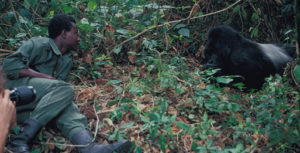 During the gorilla habituation process, tourist are given more time to learn about their way of life, take more photos, watch them interact, feed, build nests and groom themselves. Tourists also get to understand the role each individual plays in the family. The Gorilla habituation experience permit costs $1500 compared to the $700 paid for the one hour gorilla trekking. The cost of Gorilla trekking in Uganda is therefore less expensive than the habituation experience. The Uganda Wildlife Authority currently has only one gorilla group in Rushaga open for the gorilla habituation experience. The Bikyinji family consists of 22 members. This group is composed of a dominant silverback called Bahati (Derived from the place in which the group was first sighted) who controls three adult females, one infant, a juvenile, one sub-adult and a black back. There is another interesting article about gorilla trekking Vs Habituation.
During the gorilla habituation process, tourist are given more time to learn about their way of life, take more photos, watch them interact, feed, build nests and groom themselves. Tourists also get to understand the role each individual plays in the family. The Gorilla habituation experience permit costs $1500 compared to the $700 paid for the one hour gorilla trekking. The cost of Gorilla trekking in Uganda is therefore less expensive than the habituation experience. The Uganda Wildlife Authority currently has only one gorilla group in Rushaga open for the gorilla habituation experience. The Bikyinji family consists of 22 members. This group is composed of a dominant silverback called Bahati (Derived from the place in which the group was first sighted) who controls three adult females, one infant, a juvenile, one sub-adult and a black back. There is another interesting article about gorilla trekking Vs Habituation.
What happens during gorilla habituation experience in Bwindi?
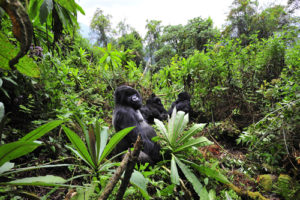 Visitors booked for gorilla habituation habituation experience gather at the Rushaga sector of Bwindi for briefing by park officials and the research team at 7:30 am before commencing the activity at 8:00am. The minimum age for the gorilla habituation experience in Uganda is 15 years of age. One needs to be fit enough to take part in the gorilla habituation process. This is because the activity may include hiking through steep and dense parts of the forest. Those with an infectious disease are not allowed to take part in the gorilla habituation process. Human diseases like flu can threaten an entire gorilla family. Tourists are not allowed to use flash camera lights while observing gorillas. Keep a distance of at least 7 meters away to avoid provoking them.
Visitors booked for gorilla habituation habituation experience gather at the Rushaga sector of Bwindi for briefing by park officials and the research team at 7:30 am before commencing the activity at 8:00am. The minimum age for the gorilla habituation experience in Uganda is 15 years of age. One needs to be fit enough to take part in the gorilla habituation process. This is because the activity may include hiking through steep and dense parts of the forest. Those with an infectious disease are not allowed to take part in the gorilla habituation process. Human diseases like flu can threaten an entire gorilla family. Tourists are not allowed to use flash camera lights while observing gorillas. Keep a distance of at least 7 meters away to avoid provoking them.
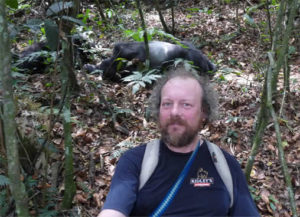 The best time for the gorilla habituation experience is usually during the dry seasons that run from December through to March and June to October. However you can also register for the activity during the low season of April, May, October, or November. These are characterized by heavy rains which can make hiking more difficult.
The best time for the gorilla habituation experience is usually during the dry seasons that run from December through to March and June to October. However you can also register for the activity during the low season of April, May, October, or November. These are characterized by heavy rains which can make hiking more difficult.
Due to the high demand for the gorilla habituation experience and given the low number of permits per day, you need to make your booking early – at least 6 months in advance. Permits can be got through the Uganda Wildlife Authority or directly from your tour operator. Your passport information will be required to book the permits.
What to Pack for the Gorilla Habituation Experience
The Packing list should include long sleeved shirts made of synthetic material, gardening gloves, a hut, long trousers, a rain jacket, bottles of drinking water, hiking shoes, a camera, a walking stick and of course insect repellents to protect you against mosquito bites. Tourists should ensure that they pack some lunch/snacks because the habituation experience takes a long time. It is important to consider hiring porters to help carry any heavy equipment or assist when climbing steep slopes.
How to get to Bwindi Forest
There are three main ways to get to Bwindi Impenetrable Forest National Park. The cheapest way is to drive from Kampala/Entebbe in Uganda or Kigali in Rwanda to the park. The drive from Kampala/Entebbe to Bwindi takes 10 hours. The route from Kigali in Rwanda is shorter taking about 4 hours.
The shortest and most convenient way of getting to Bwindi is to take a Charter flight from Entebbe or Kajjansi. The flight ends in Kisoro airstrip and takes one hour and a half. Once at the airstrip, you need to endure a 45 minutes drive to your lodge in Rushaga.

